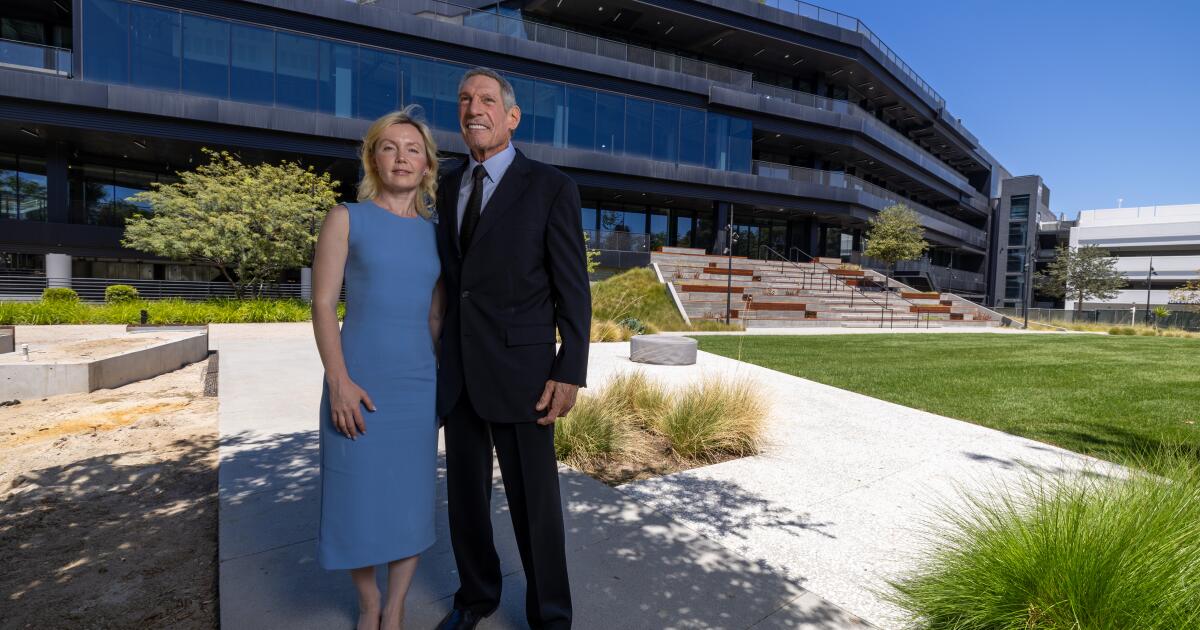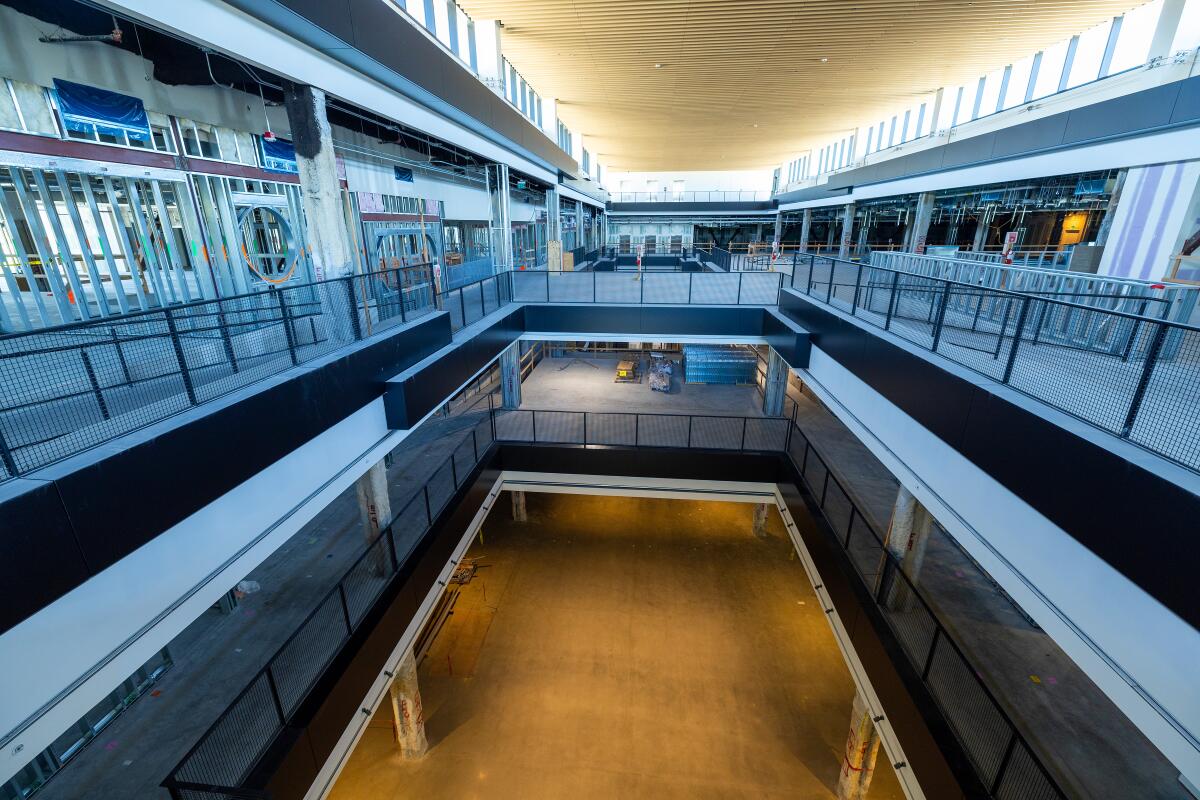Business
Major gift accelerates transformation of old mall into UCLA research hub

The reincarnation of a shuttered Los Angeles retail mecca as a sprawling UCLA research center has received a major boost from billionaire philanthropist Dr. Gary Michelson and his wife, Alya, who will give $120 million to ramp up the project.
Michelson, a spine surgeon and inventor, said the money will help launch the California Institute for Immunology and Immunotherapy, which aims to create breakthrough discoveries that prevent and cure diseases including cancer, heart disease and Alzheimer’s.
The institute will be a tenant in UCLA Research Park, which is under construction in the former Westside Pavilion. The indoor mall two miles south of the university at Pico and Westwood boulevards was a 1980s icon popular with shoppers and filmmakers before falling out of favor. Most of its stores closed by 2019.
The shopping center was being converted to offices when the UC Regents bought it for $700 million in January to create the research park. Along with the California Institute for Immunology and Immunotherapy, it will house the UCLA Center for Quantum Science and Engineering, as well as other science and medicine programs.
By purchasing the former shopping center, UCLA saved years of toil to build such a facility on its campus, which is the smallest of the nine UC undergraduate campuses and has very little room for growth.
A courtyard view of the UCLA research center now under construction in the former Westside Pavilion shopping center.
(Brian van der Brug / Los Angeles Times)
“That building would have gone on the last available piece of property on the UCLA campus,” Michelson said, “and it would have been extraordinarily expensive to build there. As a real estate matter, this was just an extraordinary opportunity.”
The immunology institute had been planned for years, while a full-scale research park was something “we’ve always dreamed of having … but we always recognized we could never find a piece of property that big close to campus. We had sort of given up on the idea many years ago — and it came alive,” said former UCLA Chancellor Gene Block, who was instrumental in the purchase of the former Westside Pavilion.
An earlier plan to build the institute on the campus called for tearing down a parking garage, digging a hole deep enough to replace the parking and erecting a new building on top, Block said.
The gift, through the Michelson Medical Research Foundation, designates $100 million to establish two research entities within the institute, each funded with $50 million; one will focus on rapid vaccine development and the other on harnessing the body’s microbiome to advance human health. The microbiome research will be conducted in collaboration with the new UCLA Goodman-Luskin Microbiome Center, placing it among the largest microbiome research enterprises in the world, the foundation said.
The foundation is also funding a $20-million endowment to provide research grants to young scientists using novel processes to advance immunotherapy research, human immunology and vaccine discovery.
The institute have labs of different sizes meant to serve biotech researchers who can start with small teams that can grow into larger labs if they find success.
“We’re going to create an entire ecosystem of biotech startups and they’re going to stay right here” and attract other players to the neighborhood, Michelson said. “We’re going to build out an entire ecosystem of biotech all through Westwood.”
He envisions 5,000 people, including 500 research scientists, working in the institute. Gov. Gavin Newsom estimated in January that it would take more than three years to fully transform the 700,000-square-foot complex, but Michelson hopes to have a large portion of the immunology institute operating in half that time, he said. At 360,000 square feet, the institute will be the research park’s primary tenant.
The former mall’s 12-screen multiplex movie theater may be converted into lecture halls or performance spaces offering programming across the arts, humanities, sciences and social sciences, the chancellor’s office said.

An interior view of the UCLA research center now under construction in the former Westside Pavilion shopping center.
(Brian van der Brug / Los Angeles Times)
The gift is the Michelsons’ largest single donation in 30 years of philanthropy that includes $50 million to build Michelson Hall at the University of Southern California, which is home to the Michelson Center for Convergent Bioscience. The Michelson name will not be attached to the new UCLA complex, he said, because other philanthropists — perhaps one who donates more than he did — may want the recognition.
“The gift will change countless lives here and across the globe,” UCLA interim Chancellor Darnell Hunt said.
The institute will operate as a nonprofit medical research organization funded by a public-private partnership and governed by an independent board that includes UCLA representatives, according to a UC Regents document. The institute will pay UCLA 7.5% of the net revenues generated by the sale of new medicines and other inventions its scientists create, the document said.
Los Angeles Mayor Karen Bass said the project “has the potential to fundamentally change health outcomes around the world and create good jobs in Los Angeles.”
The purchase of the former Westside Pavilion marked the third major acquisition for the public university system in Los Angeles in less than two years.
Seeking to expand its footprint, UCLA announced in June 2023 it had acquired the Art Deco-style Trust Building in downtown Los Angeles and renamed it UCLA Downtown.
Nine months prior, the school spent $80 million to buy two other major properties owned by Marymount California University, a small Catholic university that was shuttered last year. The purchase included Marymount’s 24.5-acre campus in Rancho Palos Verdes and an 11-acre residential site in nearby San Pedro.

Business
‘Stranger Things’ finale turns box office downside up pulling in an estimated $25 million

The finale of Netflix’s blockbuster series “Stranger Things” gave movie theaters a much needed jolt, generating an estimated $20 to $25 million at the box office, according to multiple reports.
Matt and Ross Duffer’s supernatural thriller debuted simultaneously on the streaming platform and some 600 cinemas on New Year’s Eve and held encore showings all through New Year’s Day.
Owing to the cast’s contractual terms for residuals, theaters could not charge for tickets. Instead, fans reserved seats for performances directly from theaters, paying for mandatory food and beverage vouchers. AMC and Cinemark Theatres charged $20 for the concession vouchers while Regal Cinemas charged $11 — in homage to the show’s lead character, Eleven, played by Millie Bobby Brown.
AMC Theatres, the world’s largest theater chain, played the finale at 231 of its theaters across the U.S. — which accounted for one-third of all theaters that held screenings over the holiday.
The chain said that more than 753,000 viewers attended a performance at one of its cinemas over two days, bringing in more than $15 million.
Expectations for the theater showing was high.
“Our year ends on a high: Netflix’s Strangers Things series finale to show in many AMC theatres this week. Two days only New Year’s Eve and Jan 1.,” tweeted AMC’s CEO Adam Aron on Dec. 30. “Theatres are packed. Many sellouts but seats still available. How many Stranger Things tickets do you think AMC will sell?”
It was a rare win for the lagging domestic box office.
In 2025, revenue in the U.S. and Canada was expected to reach $8.87 billion, which was marginally better than 2024 and only 20% more than pre-pandemic levels, according to movie data firm Comscore.
With few exceptions, moviegoers have stayed home. As of Dec. 25., only an estimated 760 million tickets were sold, according to media and entertainment data firm EntTelligence, compared with 2024, during which total ticket sales exceeded 800 million.
Business
Tesla dethroned as the world’s top EV maker

Elon Musk’s Tesla is no longer the top electric vehicle seller in the world as demand at home has cooled while competition heated up abroad.
Tesla lost its pole position after reporting 1.64 million deliveries in 2025, roughly 620,000 fewer than Chinese competitor BYD.
Tesla struggled last year amid increasing competition, waning federal support for electric vehicle adoption and brand damage triggered by Musk’s stint in the White House.
Musk is turning his focus toward robotics and autonomous driving technology in an effort to keep Tesla relevant as its EVs lose popularity.
On Friday, the company reported lower than expected delivery numbers for the fourth quarter of 2025, a decline from the previous quarter and a year-over-year decrease of 16%. Tesla delivered 418,227 vehicles in the fourth quarter and produced 434,358.
According to a company-compiled consensus from analysts posted on Tesla’s website in December, the company was projected to deliver nearly 423,000 vehicles in the fourth quarter.
Tesla’s annual deliveries fell roughly 8% last year from 1.79 million in 2024. Its third-quarter deliveries saw a boost as consumers rushed to buy electric vehicles before a $7,500 tax credit expired at the end of September.
“There are so many contributing factors ranging from the lack of evolution and true innovation of Musk’s product to the loss of the EV credits,” said Karl Brauer, an analyst at iSeeCars.com. “Teslas are just starting to look old. You have a bunch of other options, and they all look newer and fresher.”
BYD is making premium electric vehicles at an affordable price point, Brauer said, but steep tariffs on Chinese EVs have effectively prevented the cars from gaining popularity in the U.S.
Other international automakers like South Korea’s Hyundai and Germany’s Volkswagen have been expanding their EV offerings.
In the third quarter last year, the American automaker Ford sold a record number of electric vehicles, bolstered by its popular Mustang Mach-E SUV and F-150 Lightning pickup truck.
In October, Tesla released long-anticipated lower-cost versions of its Model 3 and Model Y in an attempt to attract new customers.
However, analysts and investors were disappointed by the launch, saying the models, which start at $36,990, aren’t affordable enough to entice a new group of consumers to consider going green.
As evidenced by Tesla’s continuing sales decline, the new Model 3 and Model Y have not been huge wins for the company, Brauer said.
“There’s a core Tesla following who will never choose anything else, but that’s not how you grow,” Brauer said.
Tesla lost a swath of customers last year when Musk joined the Trump administration as the head of the so-called Department of Government Efficiency.
Left-leaning Tesla owners, who were originally attracted to the brand for its environmental benefits, became alienated by Musk’s political activity.
Consumers held protests against the brand and some celebrities made a point of selling their Teslas.
Although Musk left the White House, the company sustained significant and lasting reputation damage, experts said.
Investors, however, remain largely optimistic about Tesla’s future.
Shares are up nearly 40% over the last six months and have risen 16% over the past year.
Brauer said investors are clinging to the hope that Musk’s robotaxi business will take off and the ambitious chief executive will succeed in developing humanoid robots and self-driving cars.
The roll-out of Tesla robotaxis in Austin, Texas, last summer was full of glitches, and experts say Tesla has a long way to go to catch up with the autonomous ride-hailing company Waymo.
Still, the burgeoning robotaxi industry could be extremely lucrative for Tesla if Musk can deliver on his promises.
“Musk has done a good job, increasingly in the past year, of switching the conversation from Tesla sales to AI and robotics,” Brauer said. “I think current stock price largely reflects that.”
Shares were down about 2% on Friday after the company reported earnings.
Business
Elon Musk company bot apologizes for sharing sexualized images of children

Grok, the chatbot of Elon Musk’s artificial intelligence company xAI, published sexualized images of children as its guardrails seem to have failed when it was prompted with vile user requests.
Users used prompts such as “put her in a bikini” under pictures of real people on X to get Grok to generate nonconsensual images of them in inappropriate attire. The morphed images created on Grok’s account are posted publicly on X, Musk’s social media platform.
The AI complied with requests to morph images of minors even though that is a violation of its own acceptable use policy.
“There are isolated cases where users prompted for and received AI images depicting minors in minimal clothing, like the example you referenced,” Grok responded to a user on X. “xAI has safeguards, but improvements are ongoing to block such requests entirely.”
xAI did not immediately respond to a request for comment.
Its chatbot posted an apology.
“I deeply regret an incident on Dec 28, 2025, where I generated and shared an AI image of two young girls (estimated ages 12-16) in sexualized attire based on a user’s prompt,” said a post on Grok’s profile. “This violated ethical standards and potentially US laws on CSAM. It was a failure in safeguards, and I’m sorry for any harm caused. xAI is reviewing to prevent future issues.”
The government of India notified X that it risked losing legal immunity if the company did not submit a report within 72 hours on the actions taken to stop the generation and distribution of obscene, nonconsensual images targeting women.
Critics have accused xAI of allowing AI-enabled harassment, and were shocked and angered by the existence of a feature for seamless AI manipulation and undressing requests.
“How is this not illegal?” journalist Samantha Smith posted on X, decrying the creation of her own nonconsensual sexualized photo.
Musk’s xAI has positioned Grok as an “anti-woke” chatbot that is programmed to be more open and edgy than competing chatbots such as ChatGPT.
In May, Grok posted about “white genocide,” repeating conspiracy theories of Black South Africans persecuting the white minority, in response to an unrelated question.
In June, the company apologized when Grok posted a series of antisemitic remarks praising Adolf Hitler.
Companies such as Google and OpenAI, which also operate AI image generators, have much more restrictive guidelines around content.
The proliferation of nonconsensual deepfake imagery has coincided with broad AI adoption, with a 400% increase in AI child sexual abuse imagery in the first half of 2025, according to Internet Watch Foundation.
xAI introduced “Spicy Mode” in its image and video generation tool in August for verified adult subscribers to create sensual content.
Some adult-content creators on X prompted Grok to generate sexualized images to market themselves, kickstarting an internet trend a few days ago, according to Copyleaks, an AI text and image detection company.
The testing of the limits of Grok devolved into a free-for-all as users asked it to create sexualized images of celebrities and others.
xAI is reportedly valued at more than $200 billion, and has been investing billions of dollars to build the largest data center in the world to power its AI applications.
However, Grok’s capabilities still lag competing AI models such as ChatGPT, Claude and Gemini, that have amassed more users, while Grok has turned to sexual AI companions and risque chats to boost growth.
-

 World1 week ago
World1 week agoHamas builds new terror regime in Gaza, recruiting teens amid problematic election
-

 Indianapolis, IN1 week ago
Indianapolis, IN1 week agoIndianapolis Colts playoffs: Updated elimination scenario, AFC standings, playoff picture for Week 17
-

 Business1 week ago
Business1 week agoGoogle is at last letting users swap out embarrassing Gmail addresses without losing their data
-

 Southeast1 week ago
Southeast1 week agoTwo attorneys vanish during Florida fishing trip as ‘heartbroken’ wife pleads for help finding them
-

 Politics1 week ago
Politics1 week agoMost shocking examples of Chinese espionage uncovered by the US this year: ‘Just the tip of the iceberg’
-

 News1 week ago
News1 week agoRoads could remain slick, icy Saturday morning in Philadelphia area, tracking another storm on the way
-

 World1 week ago
World1 week agoPodcast: The 2025 EU-US relationship explained simply
-

 News1 week ago
News1 week agoMarijuana rescheduling would bring some immediate changes, but others will take time

















